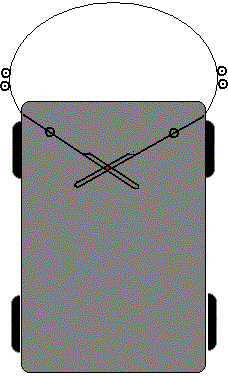
This was a little girls Science Fair entry. It was years ago and I didn't
get her name or any other details, but I have never forgotten the idea.
 Just a regular car with a large spring steel "bumper" that
loops out in front of the car and is connected to hinges (vertical axis)
at the left and right. The average angle of the hinges controls the
steering of the car. The difference between the angles controls the
speed (acceleration or deceleration) so that when the spring loop is squeezed
on the left and right, the car accelerates and when it is compressed at the
front, it decelerates. Coupling the main spring to the controls with weaker
or stronger spring segments allows for more or less control by the driver
over the system.
Just a regular car with a large spring steel "bumper" that
loops out in front of the car and is connected to hinges (vertical axis)
at the left and right. The average angle of the hinges controls the
steering of the car. The difference between the angles controls the
speed (acceleration or deceleration) so that when the spring loop is squeezed
on the left and right, the car accelerates and when it is compressed at the
front, it decelerates. Coupling the main spring to the controls with weaker
or stronger spring segments allows for more or less control by the driver
over the system.
Small roller blade type wheels on the sides of the loop keep it from wearing
as it follows a "curb" and could serve as electrical contact points for an
electrified road. Existing roadways would need additional "curbs" in between
lanes. This is much less costly than any other system I have seen, and could
be done over time in different areas. There would still be a cost, and on
street parking would be a problem.
Speed is proportional to the inverse of the distance between the curbs. Maximum
speed is maintained when the car is held to the narrowest path. The car coasts
when there is no contact left or right.
A similar spring in the back adds to the safety in case of collision. To
prevent high speed collisions, additional forward looking sensors would reduce
speed unless a clear path is seen ahead. Possibilities include laser range
finders, radar, or image recognition systems. But I personally like the idea
of a long pole that is pushed out the front of the car as speed increases
and retracted as the car slows. It would act to dampen possible steering
oscillations at high speed as well as providing a very reliable indication
of obstacles.
At a minimum, the front of the spring loop must be slightly pointed, like
the prow of a boat, so that when two different paths are possible, it will
tend to select one or the other rather than just stopping at the dividing
point. Turnoffs consist of an area wide enough to cause cars to coast followed
by a division in the road. By default, cars will continue straight. A bias
in steering (from the user or an actuator) can cause the car to turn and
select a different path.
Stop signs can be replaced with a set of poles that can be pushed over but
will lock upright if any other pole is down. Stop lights would add a timed
mechanical lock that would keep one path open for a time, then switch to
the other.
Since the speed of the car is controlled by the construction of the road,
speed limits would be built in and enforcement would be reduced to periodic
vehicle inspection and calibration.
The system is much less complex and less costly than air bags, more effective
than "crumple zones" and reduces the possibility of "pilot error" as a cause
of accidents.
The rollers at the left and right edge of the spring are an ideal location for electric power pickups. Freeways converted for this use could support electic cars with very small batteries which rely on the power grid for long distance travel.
+
file: /Techref/idea/sanecar.htm, 3KB, , updated: 2005/3/23 17:42, local time: 2025/8/11 14:58,
216.73.216.37,10-3-192-203:LOG IN
|
| | ©2025 These pages are served without commercial sponsorship. (No popup ads, etc...).Bandwidth abuse increases hosting cost forcing sponsorship or shutdown. This server aggressively defends against automated copying for any reason including offline viewing, duplication, etc... Please respect this requirement and DO NOT RIP THIS SITE. Questions?
<A HREF="http://massmind.ecomorder.com/techref/idea/sanecar.htm"> The "Sane" Automobile</A> |
| Did you find what you needed?
|
| |
Welcome to ecomorder.com!
|
| |
Welcome to massmind.ecomorder.com!
|
.
 Just a regular car with a large spring steel "bumper" that
loops out in front of the car and is connected to hinges (vertical axis)
at the left and right. The average angle of the hinges controls the
steering of the car. The difference between the angles controls the
speed (acceleration or deceleration) so that when the spring loop is squeezed
on the left and right, the car accelerates and when it is compressed at the
front, it decelerates. Coupling the main spring to the controls with weaker
or stronger spring segments allows for more or less control by the driver
over the system.
Just a regular car with a large spring steel "bumper" that
loops out in front of the car and is connected to hinges (vertical axis)
at the left and right. The average angle of the hinges controls the
steering of the car. The difference between the angles controls the
speed (acceleration or deceleration) so that when the spring loop is squeezed
on the left and right, the car accelerates and when it is compressed at the
front, it decelerates. Coupling the main spring to the controls with weaker
or stronger spring segments allows for more or less control by the driver
over the system.